Forward-facing sonar has completely changed the way anglers fish for bass, crappie and catfish. In reservoirs, rivers and lakes, anglers find fish, pick out the fish they want and specifically target those fish. This type of sonar also has increased the odds for younger anglers who have grown up playing video games that contain similar features to forward-facing sonar. This has given them the edge to beat some of the best, older bass fishermen in the nation. This technique involves locating fish in open water, determining the direction in which they are moving, casting your lure to fall in front of and close by the fish and seeing how the fish react or don’t react to the lures presented to them. This tactic is very effective in open water to pinpoint suspended bass related to schools of baitfish.
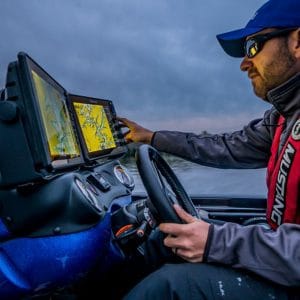
John Phillips
“The difference between forward-facing (and side-view) sonar, and the sonar used for years by anglers is that the young people who know how to use this technique are making fewer casts and catching more bass and crappie than older anglers do,” four-time Bassmaster Classic winner, Rick Clunn, says.” Anglers like Kevin VanDam and myself once made more than 2,000 casts in a day of fishing, hoping that one of those casts would land close to a bass that would eat our lures. But with forward-facing sonar, anglers can make only 200 casts per day, and each of those casts will be to a bass and have a reasonable chance of catching it.”
When forward-facing sonar first came out, many anglers considered it a gimmick to get fishermen to buy an expensive, new sonar. Many older anglers were reluctant to change and to believe the technology could help them fish better. However, the best bass anglers are never too old to learn new things.
As Kevin VanDam of Kalamazoo, Michigan, winner of four Bassmaster Classics who’s made $7 million in bass tournaments, explains, “Forward-facing sonar has completely changed what I’ve thought, believed and practiced for 30-plus years of competitive bass fishing. This new sonar has shown me that more bass are in the lakes I fish than I’ve ever assumed, and often in places I’ve never looked or thought to fish. This sonar also shows me what a bass does when it sees my lure.”
A few other anglers fishing forward-facing sonar successfully include: Dustin Connell, who won $300,000 in March, 2024, fishing Major League Fishing’s Red Crest Championship; and Hayden Marbut, who won $100,000 fishing a Bassmaster Elite tournament in February, 2024.
Technology Takes the Guesswork Out of Fishing
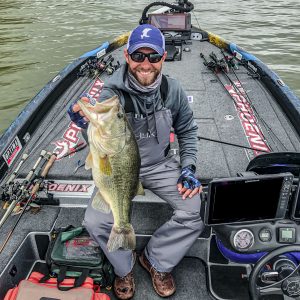
John Phillips
Randy Howell, the winner of the 2014 Bassmaster Classic, today fishes the Major League Fishing Tour. He says, “We’re seeing younger bass fishermen moving up to pro-level fishing and being competitive in their early 20s because they know how to use new technology that resembles a video game. Look at what Auburn University students, Tucker Smith and Logan Parks did – winning over $1 million in cash and prizes at the 2021 Bass Pro Shops Amateur Team Championship using this new technology.
“With forward-facing sonar, you don’t have to guess about pinpointing bass. You can see the fish, determine their sizes, learn how they’re positioned in the water, understand the direction they’re heading and the depth they’re holding on and how they’re relating to your lure, and then set the hook just as a bass takes it. I compare forward-facing sonar to sight-fishing, with the technology technique replacing the fisherman’s eyes.”
“Young people who have grown-up in the video-game world use new technology more than older anglers do. They know what the depth finder is showing them and how to react and use that information. Also, there’s vast information on YouTube from all three companies making forward-facing sonar (Garmin, Lowrance and Humminbird) about how to use it. Young anglers spend more time using the forward-facing sonar and finding fish than they spend casting,” said Howell.
Differentiating Between Fish Species
Howell learned what the various fish species looked like when watching a Lowrance ActiveTarget screen – in deep water and shallow. “During bass season, just about every bass I weighed in during a tournament I’d seen on my ActiveTarget before I ever casted,” Howell emphasizes. “I realized that learning how to use this new sonar had improved my bass fishing.
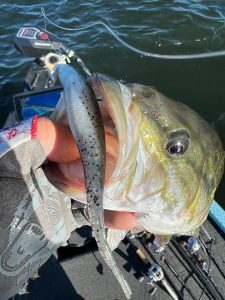
John Phillips
If I see a stump, a log or a bush in water 3 to 6 feet deep, I can use my ActiveTarget to look all the way around the structure, locate where the bass are holding and know where to cast to catch these fish. I can see through underwater grass, identify the holes in the grass and see the bass, see which fish are looking for bait, cast to them and catch them.” Howell mentions he can’t always see his lure in relation to the bass, but at least he knows a bass is where he’s casting.
“Many young anglers are also using Aqua-Vu cameras that plug into the backs of their Lowrance ActiveTarget screens and enable them to see the bass showing on them,” Howell says. “They’re watching fish in real time.” As far as species identification, much can be assessed because of the of habitat they’re in, the depth, water temperature and type of structure they favor.
Howell says he hopes the technology’s next advance is a Lowrance underwater camera that’s incorporated into the ActiveTarget. Then all he’ll have to do is push a button to make the camera zoom in for a closer look at the fish in color on his screen.
How Nania Uses Forward-Facing Sonar
Joey Nania guides on rivers and lakes across the South and fishes the Bassmaster Opens. He explains, “I’ve primarily been a bass-fishing guide and always have hated crappies because they generally hold in brush or some other type of structure. But, with my Garmin LiveScope that I use all day, every day, I can see the brush and the crappie, watch my jig fall and see a crappie take it. I’ve also learned that many-more crappies are in lakes I fish than I’ve ever thought. About 75% of the fish I catch, I’ve seen on my screen first.”
Nania uses the Garmin ECHOMAP Ultra 106 unit with a 10-inch screen. “I’ve learned from this unit that this sonar is much-more precise and enables me to locate many-more fish. With this unit I can even determine if the fish will bite quickly or aren’t hungry, compared to when I’m using my side-scanning or down-scanning sonar. With down- or side-scanning sonar, I may have to go across a point several times to spot the structure and learn where the bass are and at what water depth they’re holding. However, with forward-facing sonar, I can see everything on that point, including the brush and the fish, and I can catch them quicker. I’ve also learned so much more than I’ve ever known about how bass behave, and how and where they move. Many-more bass are suspended in open water than I’ve ever believed.”
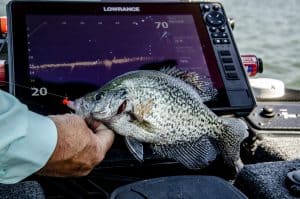
John Phillips
“To catch predator fish, when I spot baitfish on the surface, I move toward them with my forward-facing sonar to identify the kind of nearby fish – bass, crappie, gar, drum or catfish – eyeballing that school for a potential meal,” Nania reports. “I’m looking for predator fish. If they’re actively feeding, they won’t be schooling but will be swimming fast, rarely sitting still in the water. I can tell how big the predator is with my forward-facing sonar.
“I determine in what direction the fish are moving and cast out in front of them, deciding how long my bait needs to sink to reach the predator’s strike zone. Sometimes, I’ll see fish 55-feet down and cast a long way in front of them. If I spot a bass moving quickly toward my bait, I’ll move the bait away with a quick jerk and then usually the bass will take it.”
Most anglers believe that forward-facing sonar is used primarily for finding open-water, suspended bass that aren’t relating to any type of structure. However, Nania explains, “I also use forward-facing sonar to understand underwater structure better. For instance, if I spot a tree limb sticking out of the water, I can see the entire tree underwater, find the trunk and continue to look down the trunk, until I spot the underwater root ball of the tree – where I’ll usually make my first cast.” “I use my forward-facing sonar when I pinpoint offshore hydrilla and/or milfoil,” Nania says. “This new sonar enables me to see how thick the grass is, where the holes in the grass are, where bass generally stay, and where the high spots are on the bottom. In the past, once I saw underwater grass, I’d fish blindly down the grass line, not knowing where the bass were. Today, by seeing the underwater grass on my depth finder, I can run a lure right over the tops of the grass, let it tick these tops, watch how my lure’s running and prevent it from getting hung in the grass.”
 Nania’s Equipment Set-Up
Nania’s Equipment Set-Up
Nania has one depth finder on the front of his boat and one at the console. “I find the bait and structure with my down- and side-imaging. Then with the LiveScope attached to my trolling motor, I can study the structure or school of bait, the fish related to it and the depth where the predator fish are concentrating to know where I need to cast to them. If I spot the bass running away, I’ll get behind them and follow, casting various lures, until I find the one they want to bite.”
Nania uses his LiveScope to show him what’s around his boat in every direction and beneath at distances of up to 80 to 90 feet from the boat. “I’ve used LiveScope so much that once I see a fish, I can determine how far it is from the front of my boat and place my lure right in front of its face. Then I look at the top of my trolling motor to know where to cast.”
Tournament bass, crappie and catfish anglers and guides have probably adapted to this new forward-facing sonar because their incomes are directly tied to the number of bass, crappie and catfish they can pinpoint and catch. Forward-facing sonar pays off for every angler.
Join our weekly newsletter or subscribe to GameKeepers Magazine.
Your source for information, equipment, know-how, deals and discounts to help you get the most from every hard-earned moment in the field.

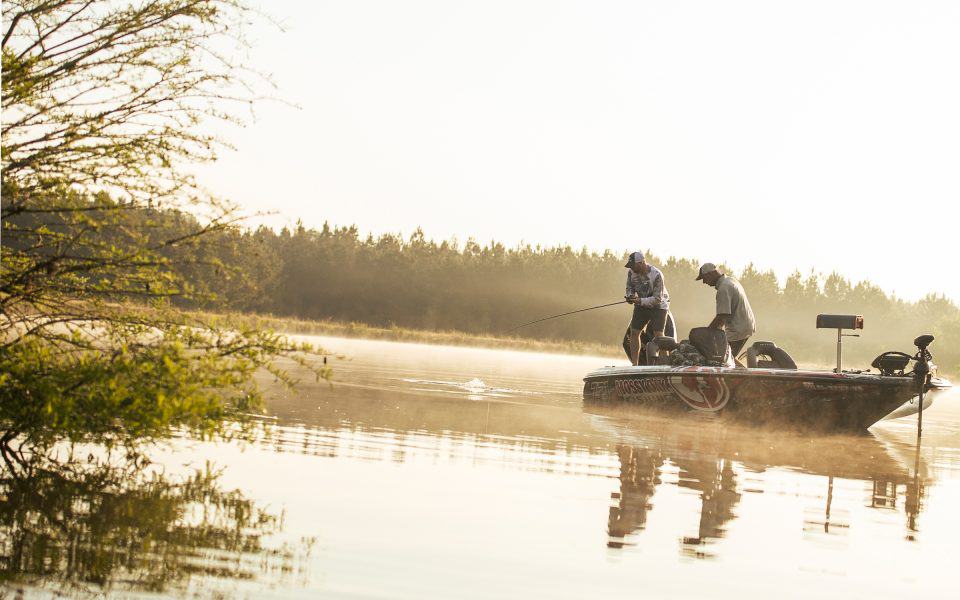
 Nania’s Equipment Set-Up
Nania’s Equipment Set-Up 






